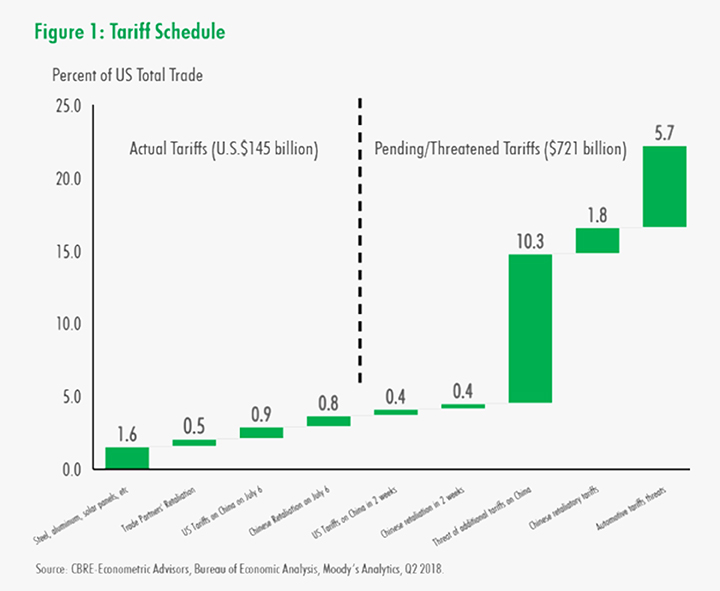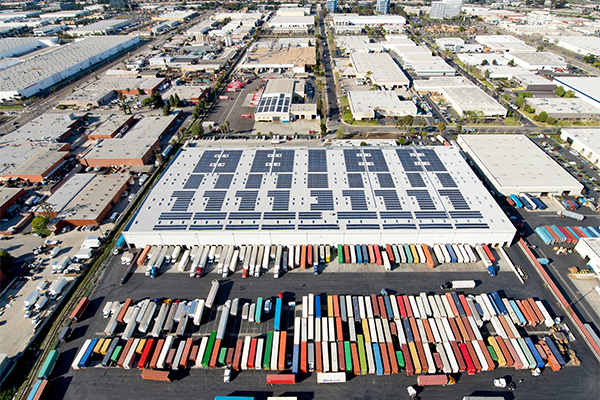A recent study conducted by the industrial real estate firm CBRE, notes that the new tariffs targeted at high-tech Chinese goods–such as industrial robots, radio transmitters, aircraft parts, computer hardware and electric cars–and is designed to put economic pressure on Beijing's “Made in China 2025” program.
The program is a Chinese government initiative to move the economy higher up the manufacturing value chain. Beijing responded immediately with a 25% tariff on 545 U.S. products worth $34 billion, largely targeting the automobile and agriculture industries.
According to Tim Savage, Senior Managing Economist and Principal Data Scientist at CBRE Econometrics Advisors, much useful news has been “lost in the rhetoric.”
“It's important to remember that China entered the World Trade Organization in the 1990's, which was the same decade that the North American Free Trade was negotiated,” he says. “It takes many years to reverse these developments.”
So while trade tensions are not to be entirely discounted, the focus should really be on other issues, Savage adds. Automation, for example, and the ongoing dynamics of e-commerce and last-mile delivery.
“A ‘worst case' scenario would be for the U.S. to completely withdraw from NAFTA and to insist that China be ejected from the WTO. But this is purely hypothetical,” concludes Savage.
No such dire tableaux is contained in another new study produced by industrial real estate giant, Prologis, however.
The research paper, tititled “Industrial Real Estate: Isolated from Recent Trade Action,” notes that while U.S. seaport markets have the biggest exposure to global trade, import centers are still only a fraction of total occupied space in these markets.
Among Prologis' U.S. markets, Southern California and New Jersey contain the highest proportion of space used as import centers, with 25% or less.
Researchers, acknowledged, though, that major intermodal markets do have vital links to global trade. Both Chicago and Dallas, for example, represent key hubs for imported containers moved immediately out of the port via a combination of rail and truck without pausing at a local logistics facility.
“While these markets are positioned along global trade routes, they are also major consumption centers, with a combined population of nearly 60 million.
Accordingly, the majority of space is used to serve local and regional consumption rather than acting as waypoints along global trade routes,” researchers concluded.

Walter Kemmsies, Ph.D. ,JLL's Managing Director, Economist and Chief Strategist, says his firm has yet to produce a similar body of work on the impact of tariffs, but agrees with most of the findings gathered by CBRE and Prologis.
“The main take-away for shippers now is for them to keep their options open,” he says. “Too much reliance on one or two ports, for example, is not smart. As all this tariff talk is reaching a crescendo, we may also expect ocean and air carriers to reconfigure their deployments and schedules. Our advice to them is simple…be prepared.”
SC
MR


Latest Supply Chain News
- Despite American political environment, global geopolitical risks may be easing
- Joseph Esteves named CEO of SGS Maine Pointe
- Employees, employers hold divergent views on upskilling the workforce
- April manufacturing output slides after growing in March
- Q1 sees a solid finish with positive U.S.-bound import growth, notes S&P Global Market Intelligence
- More News
Latest Podcast

 Explore
Explore
Business Management News
- Joseph Esteves named CEO of SGS Maine Pointe
- Employees, employers hold divergent views on upskilling the workforce
- April manufacturing output slides after growing in March
- Q1 sees a solid finish with positive U.S.-bound import growth, notes S&P Global Market Intelligence
- 6 Questions With … Sandeep Bhide
- MIT CTL offering humanitarian logistics course
- More Business Management
Latest Business Management Resources

Subscribe

Supply Chain Management Review delivers the best industry content.

Editors’ Picks





